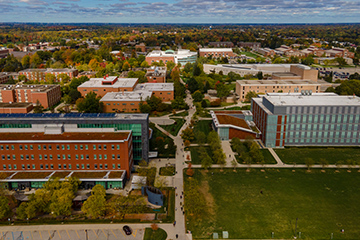Researchers to get up close and personal with hail
New technology to help team see how ice balls form inside storms

Most of what we know about hail is what it costs us after it crashes into the ground. In 2023, 17 of the 28 billion-dollar weather disasters included hail damage.

That’s the bulk of the cost for storms that roar across the Midwest, said John Allen, a faculty member in Central Michigan University’s Department of Earth & Atmospheric Sciences.
What happens inside a storm that produces hail, that’s a real mystery, Allen said. We don’t know where inside a storm it forms, how it travels inside the storm and how these storms behave when it falls from the sky.
Allen hopes that a major grant and new technology will help a multi-institutional research team – including CMU faculty, and undergraduate and graduate students – will help unlock hail’s secrets.
Researchers will roam an area from Missouri west to Colorado and Texas north to the Dakotas over six weeks next summer observing hail-producing storms. The more storms they are able to see, the more data they’ll collect.
Observing is a passive way to describe what the teams will do. They’ll go into the field armed with the latest technology – impact measuring devices, drones, artificial intelligence, portable radars, 3D scanners, probes and weather balloons – to get up close and personal with these storms.
They want to know how storms behave while hail forms inside them.
Portable Doppler radar units will help them build three-dimensional profiles of wind patterns inside storms, Allen said. Probes will record how hail forms inside storms. Drones and teams will follow storms, and use manual observations and artificial intelligence to map out the distribution of hailstones.

Making these observations is critical to improving storm forecasts and mitigating the severe economic losses from storms.
More precise data, for instance, will help improve warnings that can enable actions like homeowners knowing when to move their cars into shelter, he said. For emerging energy production like solar panels, it’ll improve our understanding of how hail may require us to rethink how we design panels.
It’s the first major hail-related research project since the 1980s.
“Hail’s been sort of left out in the cold,” Allen said. Most of the research geared toward severe thunderstorms has focused on tornadoes, which do injure and kill a lot more people than hail.
Allen is one of the research team’s four lead investigators. He’ll be joined by his colleague Jason Keeler, 10 undergraduate students and five graduate students out in the field. Among the participating institutions, CMU is the biggest part of the team.
It’s also a unique opportunity for CMU undergraduates to participate in critical research in what Allen said is “the world’s largest laboratory.”
An $11 million dollar grant from the National Science Foundation is funding the research.





